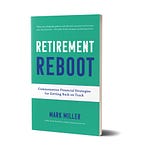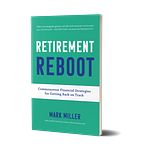
This week, the podcast takes a look at the first major retirement legislation to move through Congress in more than a decade According to some policy folks, it is the most significant retirement legislation since the passage of the Pension Protection Act (PPA) in 2006. That’s hard to debate, but only, as mentioned, because it’s the only retirement legislation to come along since PPA was passed.
Several much more pressing (“significant”) retirement matters need to be addressed by lawmakers and policymakers. One is the looming implosion of multi-employer pension plans covering more than 10 million workers and retirees. These were created under collective bargaining agreements and jointly funded by groups of employers in industries like construction, trucking, mining and food retailing. Congress has been working on a solution, and it was good to see a bill advance out of the House Education & Labor Committee this week.
Another big issue is weakened fiduciary protection for retirement savers. The Securities and Exchange Commission approved its Regulation Best Interest regulation this month; as expected, it is far weaker than the now-deceased fiduciary rule implemented by the Obama-era Department of Labor. The SEC rule relies on disclosure - here’s 100 pages of fine print, and you’re on your own.
And of course the other enormous, looming issue is Social Security reform - if nothing is done by 2035, we’re all looking at a haircut on benefits of about 25 percent.
But I digress - back to the legislation at hand - the Setting Every Community Up for Retirement Enhancement Act of 2019 - SECURE for short. The bill recently passed the House of Representatives by a lop-sided, bipartisan margin, and it is under consideration by the Senate now.
You can find more in my most recent Reuters column, but in brief, SECURE contains a laundry list of provisions that the financial services industry has wanted passed for a long time. It focuses in four key areas:
Increasing access to employer-sponsored workplace savings plans';
Getting people in these plans to save more;
Add features to workplace plans that get people to focus on how their savings translate to income in retirement
Increase financial literacy on how savings translate into spending and income in retirement.
One of the key provisions make it possible for employers to band together to offer a single workplace retirement plan to workers. This typically would be small employers. I’ve been skeptical that this will put much of a dent in the country’s workplace coverage gap. For one thing, it’s not at all clear many plan providers will jump into this market to offer plans. And more-competitive low-cost options for small employers have surfaced since this idea was first hatched some years ago.
SECURE also would make it much easier for employers to add the option of converting part of your 401k savings to an annuity at the point of retirement. The idea here is to help assure people of a higher amount of guaranteed income in retirement. Then there’s some small stuff. For example, recognizing that more people are working longer, the age when required minimum distributions must begin would increase from 70.5 to 72. And the maximum age for contributing to an IRA (also 70.5) would be repealed. (Insert yawn here.)
But I wanted to get a reasoned defense of the SECURE Act for the podcast. For that, I turned to Melissa Kahn, managing director of retirement policy for the defined contribution team at State Street Global Advisors - a very large company that manages nearly $3 trillion in assets worldwide. Melissa is an attorney with extensive experience in the world of employee benefits and regulation. Before joining State Street, she worked as a consultant in the industry and also for more than a decade working in the life insurance business. She wrote an excellent article recently that does a great job distilling what’s in the SECURE Act.
Subscribe during the Spring Sale!
This podcast is part of the newsletter I distribute to subscribers to the RetirementRevised.com newsletter. It’s a listener-supported endeavor, and I hope you’ll consider subscribing. Along with the podcast, you’ll get access to the series of retirement guides that I’m publishing right now - brief, downloadable resources to help you understand challenges like optimizing Social Security benefits, transitioning to Medicare from other types of insurance and how to hire a financial adviser. Each guide is paired with a podcast interview with a top expert in the field.
Right now, you can take advantage of the Spring sale - half off your first year. Check it out using the “subscribe now” link at the bottom of this page, or visit the website for more details.
If you’re listening on Apple Podcasts or Stitcher, please leave a review and comment to let me know what you think. You’ll be helping me get more visibility for the show. If you like what you see here, I hope you’ll consider subscribing, too.










